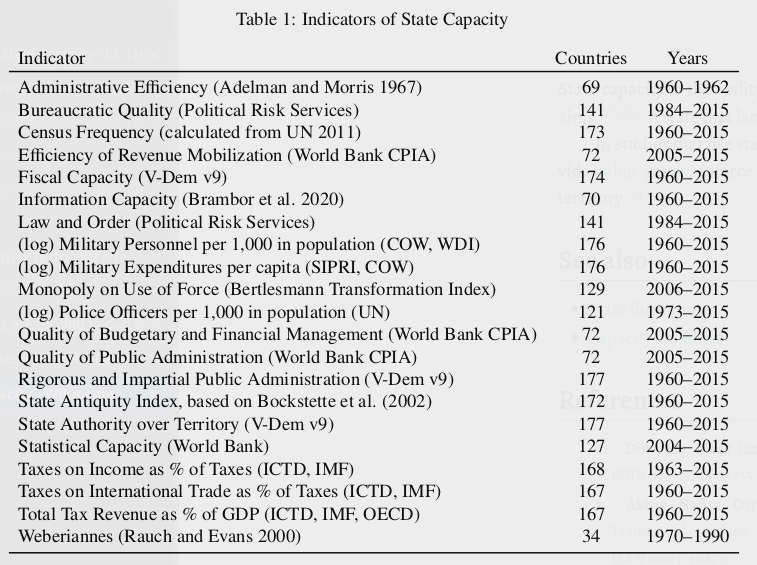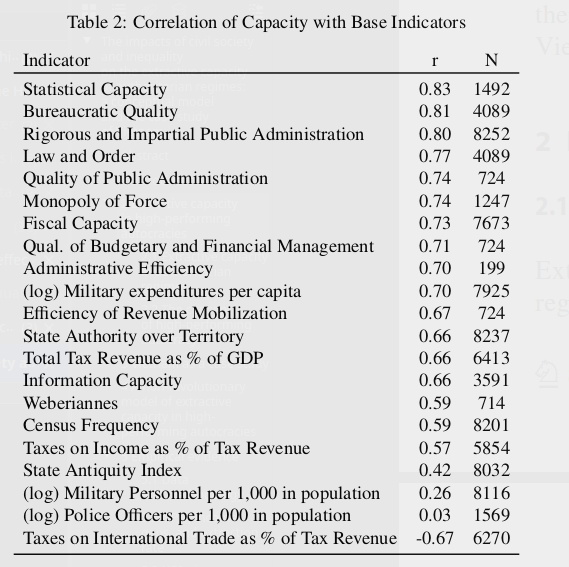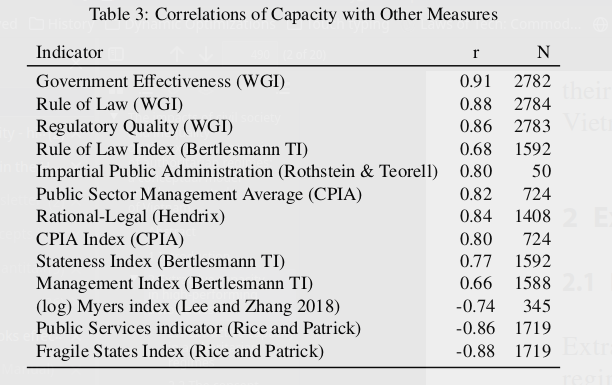- 1 What?
- 2 Why?
- 3 How?:ATTACH:
- 4 And?:ATTACH:
- 5 Bibliography
1 What?
Building a multidimensional indicator of state capacity, using latent variable analysis. The dataset is available here.
2 Why?
It is widely recognized that state institutions exert considerable influence on outcomes including economic growth, human development, civil conflict, international security, and the consolidation of democracy.
The concept of state capacity is multidimensional in nature, often vaguely defined. This makes it hard to quantify.
In a review of state capacity scholarship, Cingolani ((2013)) identifies at least seven different dimensions of state capacity in use: coercive, fiscal, administrative/implementation, transformative/industrializing, relational/territorial, legal and political capacities. We add several more to this assortment and illustrate the widely varying terminology across the literature (see the online appendix). In another comprehensive review, Berwick and Christia (2018) note that researchers often describe state capacity as involving only the aspects that they confront in their particular inquiry. The result is a confusing array of dimensions and insufficient attention to how specific dimensions relate to the broader concept of state capacity.
3 How?
- Outlined three core types of capabilities that state organizations must possess in order to fulfill those functions.
- Indicators of extractive capacity
- Indicators of coercive capacity
- Indicators of administrative capacity

Figure 1: Different indicators used in the model
- Then, state capacity are estimated by Bayesian mcmc models (implemented in R and jags, specifically).
4 And?
- The Capacity measure is scaled from \(-2.31\) to \(2.96\), with a mean of \(0.26\) and standard deviation of \(0.95\).
- The Capacity weakly correlates with measures related to military and police personnel. The authors provided three explanations:
- The Capacity measure misses aspects of coercive capacity that arise from state employment of securities personnel.
- It may be that rulers of weaker states of those who engaged in conflicts tend to expand their security forces, thereby further weakening the relationship.
- Or maybe it’s the case that the numbers of security personnel simply don’t matter.

- Over time, Capacity rose in most countries

Figure 2: Correlation of Capacity with measures that are not in the mcmc simulation
- The Capacity correlates well with both the log Myers index ((Lee and Zhang 2017)), with \(r=-.74\)
5 Bibliography
Cingolani, Luciana. 2013. “The State of State Capacity: A Review of Concepts, Evidence and Measures.” unu-merit. http://collections.unu.edu/view/UNU:40.
Lee, Melissa M., and Nan Zhang. 2017. “Legibility and the Informational Foundations of State Capacity.” The Journal of Politics 79 (1). The University of Chicago Press:118–32. https://www.journals.uchicago.edu/doi/10.1086/688053.
This post is in the collection of my public reading notes.